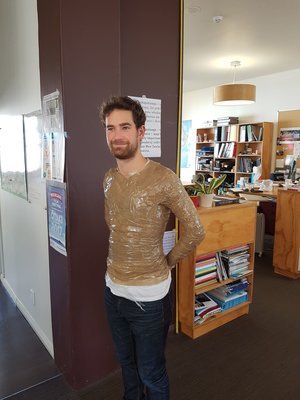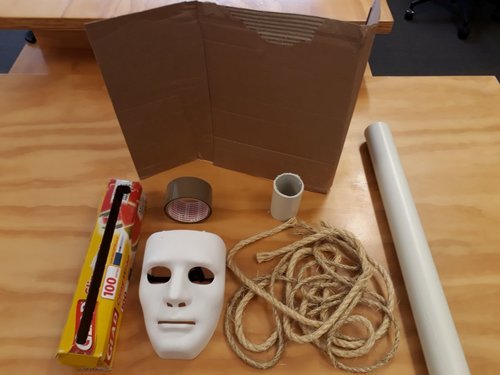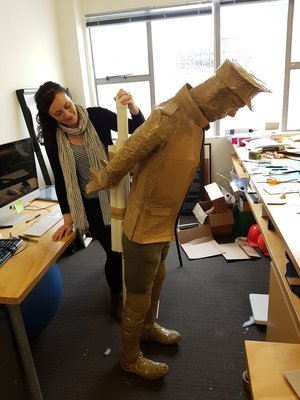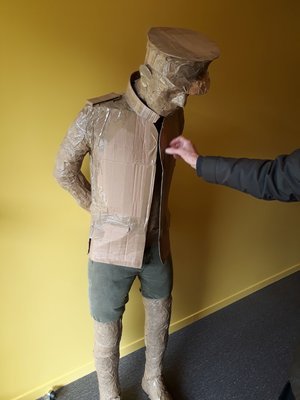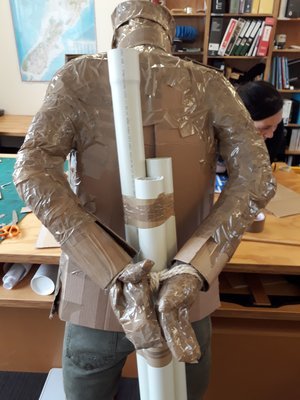Eight rolls of packing tape: The making of a Conscientious Objector
Dissent, the second episode in the seven part Chapters of Great War series of exhibitions opened at the Great War Exhibition, Pukeahu in Wellington on 21 July 2017. The exhibition tells the story of a different kind of courage from WW1 – that shown by the people who objected to the war – from conscientious objectors, to iwi leaders, and labour politicians.
A central piece of the exhibition is a figure that represents a conscientious objector being subjected to the infamous “Field Punishment No. 1”. Four New Zealand objectors were punished this way during World War 1 – tied tightly to posts near the frontline and left for many hours, day after day.
The figure was inspired by the “guerrilla sculptures” set up on the Wellington waterfront on ANZAC Day 2016 to highlight the bravery and sacrifice of those who refused to serve in the military. The sculptures were created by Peace Action Wellington and were designed to be temporary. This meant we had to recreate one based only on photographs of the originals and a short description of the materials the group used (cling wrap, tape, denim, cardboard and spray paint).
One of Peace Action Wellington's guerrilla sculptures installed at Frank Kitt's Park in Wellington on Anzac Day 2016.
After watching several Youtube videos (like the one below) about creating tape dummies we felt confident enough to make an attempt. Thankfully, Henry, one of our 3D/spatial designers was happy to be the model and muse for the occasion.
We started by wrapping Henry’s torso and arms in a layer of cling film, followed by strips of packing tape, layering them over and over until he was totally encased in a stiff shell. Because our objector was to be mounted in the No. 1 Field Punishment position, Henry had to hold his arms behind him, as though they were tied behind his back, so that we got the shape right. The cling film was intended as a base for the tape to stick to, rather than clothing or skin, making it easier (and less painful!) to cut him out of the shell once we finished. Even so, there was a moment of panic and an almost mad-dash to Cotton On when we thought that we were going to have to also cut through the t-shirt he was wearing. Some careful scissor manoeuvring averted the crisis and the exit cut was then taped back together, leaving us with a perfect shell of Henry’s torso and arms.
Spurred on by our early success the same process was repeated on Henry’s lower legs (including his shoes) and hands. There was no need to wrap his upper legs because by consulting photos of PAW’s 2016 sculpture we could tell that they just used a pair of jeans for to join the torso section to the lower legs. A khaki coloured pair on special for $15 was purchased from Cotton On for this purpose.
The trickier part was the head and face. To avoid suffocating poor Henry, we purchased a somewhat creepy full face plastic mask to use as the base for the face. It was layered with the packing tape and a pair of packing tape ears completed the effect. Henry bowed his head and then his entire head (but not face) and neck, right down to his décolletage was taped. Henry sustained a couple of small cuts and the loss of a lock of hair during the removal process but luckily forgave us once we plied him with salted caramel cookies from Leeds St Bakery. Eight rolls of packing tape later we had all the pieces of our objector but still needed to bring them all together.
Because our sculpture needed to stand in the Dissent exhibition for three months he needed some interior strengthening to stop him from suffering the effects of gravity and sagging. Armed with a 6 metre PCV pipe, 4 elbow joins, two tee joins and a hacksaw, we created a frame mimicking shoulders, hips, legs and a spine. A duvet inner was torn up and used to fill the gaps between the packing tape shell and the PVC skeleton.
Our conscientious objector’s clothing was the last part to be created. His cap was made entirely of cardboard, as was his tunic including the details such as the collar and pockets. More packing tape was wrapped round the calf/knee area of our objector which served a dual purpose – joining his lower legs and feet to his upper legs made from the pair of jeans, and also creating his puttees - a key piece of WW1 soldier kit - strips of cloth wrapped around the lower leg in a spiral pattern, from the ankle up to below the knee. Finally his hands and feet were bound with rope.
The last step in the creation of the conscientious objector was painting him. Poor weather put an end to our plan to spray paint him on the roof of our office. Instead he was carefully bundled into a car and delivered to the spray booth at Anderson Design which he entered as a mixture of mismatched brown tones, but emerged as a far more uniform khaki with black boots.
Our thanks go out to Peace Action Wellington for the permission to recreate the figure in the exhibition.
Henry installing his doppelgänger at the Great War Exhibition
Coming soon: In our next Behind the Scenes at Dissent blog we’ll look at how we created the green screen videos telling the stories of different WW1 dissenters in their own words, including cameo appearances by Story Inc’s own James McLean and Steve La Hood!



